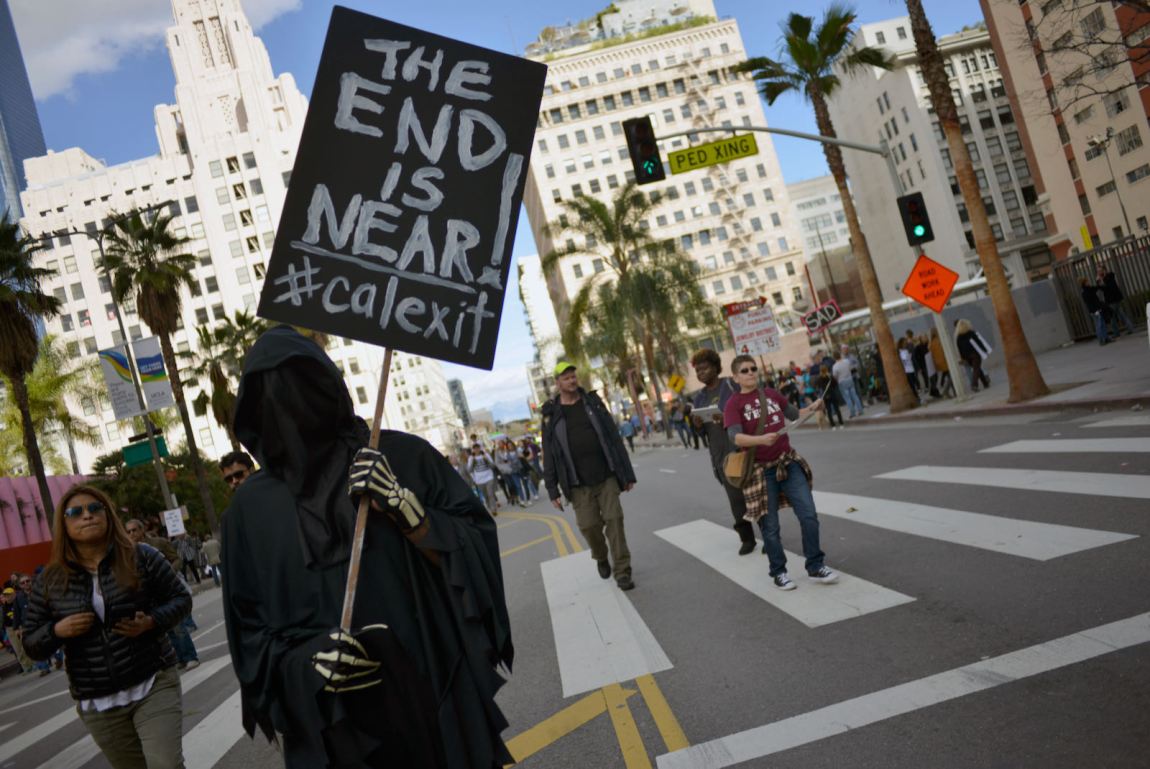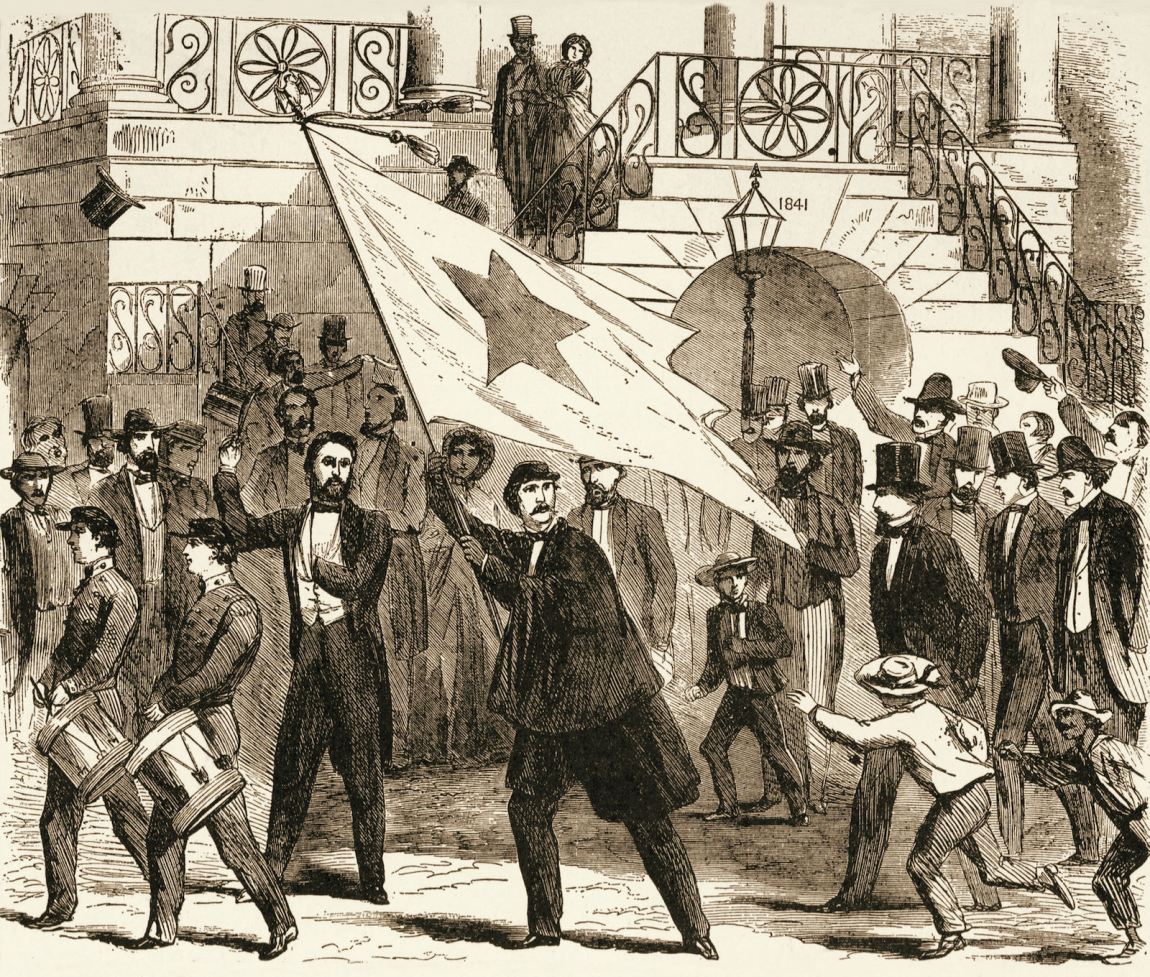After what even Republican Senate leader Mitch McConnell called, with surprising accuracy, a “failed insurrection” at the United States Capitol, the far-right fringe of the Republican Party is feeling both emboldened and disillusioned. In numerous videos from the day, members of the mob can be heard expressing astonishment that their march made it as far as the hallowed halls of the national legislature. Then a palpable disappointment took over when President Trump, instead of joining them as he had promised, put out a video asking them to withdraw and go home. A subsequent video finally conceding the election to Joe Biden and promising an orderly transition of power hardly quieted the MAGA hordes. Then the FBI officially put the country on notice that armed assaults were being planned on all fifty state capitol buildings and the now-fortressed federal one in Washington, D.C., leading up to the day of Biden’s inauguration.
What will his frustrated followers turn to next? One possibility is disorganized, disaggregated political violence—bombings, kidnappings, assassinations—effectively amounting to a new civil war, though a low-grade conflict more like the Troubles in the United Kingdom in the last decades of the twentieth century than the pitched battles fought between this country’s North and South from 1861 to 1865. The numerous explosive devices, Molotov cocktails, and other weapons found around the nation’s capital on January 6 could foreshadow the kind of mayhem that will define American political life for decades to come.
Yet there is another, related possible future for the far right and for US politics more generally: secession. Already, many right-wing commentators associated with Glenn Beck’s The Blaze and other pro-Trump outlets are using what remains of their social media platforms to call for the departure of Republican-leaning states from the Union. “You can’t change a corrupt institution by relying on corrupt officials to call out their own corruption,” Lauren Chen, a BlazeTV host, tweeted. “Secession is the answer.” If they can’t control the country and the government, nobody can. The Confederate flags the insurgents carried through the Capitol weren’t about the past, but the future.
The groundwork for this awkward transition from hard-core Trumpian nationalism to burn-it-down separatism has, in fact, been laid over several months. In December, shortly after the Supreme Court refused to hear a suit brought by Texas seeking to invalidate the 2020 election results, Allen West, a former congressman and chair of the Texas Republican Party, suggested that “law-abiding states should bond together and form a Union of states that will abide by the Constitution.” Far from immediately disavowing such an incendiary call, the state party’s official Twitter account promoted the statement. On Parler, the social media app favored by the far right (until Amazon Web Services effectively shut it down), users insisted the time had come for “succession” (sic).
It wasn’t only the clown-like Allen West. In the preceding weeks, a Texas congressman had shared a meme on Facebook endorsing independence for the Lone Star State, and a state representative announced that he would introduce a bill in the upcoming legislative session to put the question up for a referendum. Rush Limbaugh observed on his radio show that the US was “trending toward secession” and the peaceful coexistence between liberals and conservatives had become impossible. Although both Limbaugh and West later made a gesture of walking back their pro-secession comments, their followers weren’t buying it. Most recently, the chair of the Wyoming GOP wondered if his state, too, might secede.
Despite all this, most mainstream political commentators who covered the secession talk dismissed the possibility of a state’s actually trying to leave the Union as remote, even inconceivable. “The Confederacy lost,” the New York Times contributing opinion writer Wajahat Ali simply tweeted—as if that, a century and a half later, settled it.
Glib rejoinders may not suffice much longer. Secession talk should not be written off as hopeless fantasy, a fetish of the far-right fringe. Given last week’s astonishing attempt at overthrowing the government, the country’s long history of separatist movements, and the tenuous, ever-shifting balance between state and federal power, secession remains the most likely form that a full breakdown in constitutional government would take. As America’s political dysfunction gets worse, talk of secession is likely to get more and more serious, until it isn’t talk at all.
Flirtations with secession by Republicans, in Texas and elsewhere, ought instead to be taken as a harbinger of what might well be the next big thing in American politics. Just as the election of Donald Trump as president in 2016 represented a political earthquake with aftershocks that will continue for years, the return of secessionism to US politics may lead to a ground-shifting crisis that determines nothing less than whether the Union as Americans have known it will survive in anything like its present form. Far from an innocuous, exasperated expression of dissent from the direction of national politics, the right’s metastasizing skepticism about the Union itself suggests the shape that the Republican Party’s toxic radicalization will morph into next.
Advertisement
*
Perhaps the only thing left and right have in common these days is a shared suspicion—if not yet a hardened belief—that they have so little in common as to make continued cohabitation impossible, even dangerous. For several years now, opinion polls have consistently shown roughly one third of Americans supporting the idea of their own state’s leaving the Union. One recent survey showed 53 percent of Texas Republicans favor secession. While these responses are surely colored by partisan pique and likely exaggerate the depth of support for any hypothetical breakaway movement in the future, they remain startling nonetheless, suggesting that America’s commitment to national unity—as to democracy and the rule of law—may not be as rock solid as we thought.
Secession talk has risen after each of the last five presidential contests, starting with George W. Bush’s reelection in 2004, after which liberals circulated satirical online maps of North America split between a blue-shaded “United States of Canada” and a red-shaded “Jesusland.” In the years that followed, left-leaning supporters of secession from Vermont and Hawaii mingled at conferences with libertarian advocates of Alaskan independence and members of the avowedly racist League of the South. In 2009, at the dawn of the Tea Party, then Texas governor Rick Perry warned that reviving the Lone Star Republic might be necessary “if Washington continues to thumb its nose at the American people.”
After Barack Obama’s 2012 reelection, hundreds of thousands of people from every state in the Union signed WhiteHouse.Gov petitions calling for secession. The day after Trump’s 2016 win, #Calexit began trending on Twitter as a group called Yes California rallied on the steps of the state capitol, doling out copies of the state’s official Bear Flag—the one that says “California Republic”—in exchange for the Stars and Stripes. A sitting Democratic congresswoman, Zoe Lofgren, observed that “rational people, not the fringe,” were talking about making those quaint words on the state banner real.
Support for secession sways like a pendulum depending on who is in and out of power. The California movement eventually died down, done in after its Russia-residing leader quit amid reports of ties to a Kremlin-backed group. But Calexit showed that the new secessionism was remarkably bipartisan. The Texas Nationalist Movement, the largest and most sophisticated separatist group in the US today, was gaining ground in the late Obama years, though it lost momentum with Trump’s victory. But had Trump managed to win reelection this year, Californian separatism would likely have returned in force. Instead, it’s once again the Texans’ turn to gripe and groan and threaten to leave.
Last spring, when Mitch McConnell derided federal coronavirus aid to states and cities as “blue state bailouts,” many Democrats pointed out that blue-leaning states pay far more into federal coffers than they receive in return, and that, in fact, it’s the red states that have been bailed out, year after year, by a federal government funded by taxpayers in the rest of the country. Once citizens begin to see and think in such zero-sum terms, it’s hard to go back to unthinking faith in “E pluribus unum.”
*
A similar dynamic held in the United States during the years between the Revolution and the Civil War. During the presidencies of George Washington and John Adams, members of the Federalist Party fiercely defended national supremacy against criticism by states’ rights advocates like Thomas Jefferson and James Madison. But when those two Democratic-Republicans next took the White House, Federalists themselves turned so hard against the federal government as to embrace the idea of New England’s secession in protest against the War of 1812. By the 1830s and 1840s, both Southern slaveholders and Northern abolitionists began to doubt whether a Union dominated by their opponents was worth preserving.
In the 1850s, Northerners opposed to the iniquitous Fugitive Slave Law and Dred Scott decision embraced the nullification doctrines initially advocated by proslavery ideologues like Senator John C. Calhoun. “The Union was formed to establish justice and secure the blessings of liberty,” antislavery politicians declared in an influential 1854 manifesto. “When it fails to accomplish these ends it will be worthless, and when it becomes worthless it cannot long endure.” That document eventually led to the creation of the Republican Party, founded to advocate for the right of states to resist federal abuses of power. Some of its earliest members flirted with advocating outright secession from the Union.
Advertisement
Just as today’s secessionist murmurings are dismissed, Southerners’ threats in 1860 to leave the Union should Lincoln win the presidency were similarly downplayed as bluster. As today, commentators ridiculed Southern secession threats as the “old Mumbo-Jumbo,” so much “windy bombast.” Since Republicans couldn’t safely campaign in much of the South, antislavery Northerners had little understanding of how intense support for disunion had grown.
The two sides existed in their own information bubbles, with little communication across the divide. Horace Greeley’s New York Tribune scornfully predicted that “the South could no more unite upon a scheme of secession than a company of lunatics could conspire to break out of bedlam.” A journalist who visited him in Springfield, Illinois, just after the 1860 election later wrote that Lincoln considered Southern secession talk “a political game of bluff, gotten up by politicians, and meant sorely to frighten the North.” He said he trusted the “many assurances” he had received from Southern correspondents that “in no probable event will there be any very formidable effort to break up the Union.” A few months later, the president-elect faced a formidable effort to do just that.
Just as critics today point to the Confederacy’s defeat as proof that secession can go nowhere in American politics, pro-Union Southerners warned that any effort to break up the country would consign the region’s political leaders to the same “scorn and ignominy” that had attached to New England’s flirtation with secession during the War of 1812. They had, of course, other sober-minded objections—to the economic viability of a new Southern nation, the necessity of immediate action, the constitutionality of secession. Ultimately, none of it mattered. What unionists deemed irrefutable arguments against disunion the secessionists considered mere obstacles, regrettable complications.
Empowered by state-level gerrymandering that insulated an aristocratic minority of wealthy slave owners from the non-slaveholding white majority, Southern radicals made their move before moderates and unionists knew what was happening. Overnight, the very fact that the Union seemed on the brink of destruction forced them to choose sides and converted even the fiercest opponents of secession to the cause of Southern independence. One Georgia newspaper commented that the “hopelessness of preserving the Union has made disunionists, since the election, of thousands of Conservative and Union men.” As the long-threatened secession finally took shape, events gathered a momentum that became impossible to stop.
*
There is no reason to believe something similar couldn’t happen today, if not in precisely the same way. Just because there are valid objections to secession without satisfying rebuttals does not mean they cannot be overcome by skillful maneuvering and sheer force, especially in a moment of pitched crisis. People marched on the Capitol last week who, only a few years or even weeks earlier, would never have imagined themselves doing such a thing. Skeptics of the seriousness of secession talk observe that even solidly blue or red states contain sizable populations favoring the minority side. Yet neither the North nor the South was fully united in the 1860s; the lines had to be drawn somewhere.
Moreover, the changing demographics within red-leaning states like Texas may not avert a constitutional showdown but encourage it. In 1860, Southern secessionists moved to quit the Union right after Lincoln’s victory because they were fearful that the Republican Party and antislavery attitudes more generally were on the rise in slave states. If they waited any longer, they reasoned, they might lose control not only of the country but of their own states as well.
Republicans flirting with secession today seem to be making similar calculations after witnessing traditionally conservative states like Georgia and Arizona fall to the Democrats in the 2020 election. Should Texas succumb next, it would become all but impossible for the GOP to win national elections.
Surely, by now, we should be careful before dismissing far-flung political possibilities as impossible to imagine ever becoming reality. The tone with which some dismiss the threat of secession in the modern United States sounds unmistakably similar to that in which pundits assured their audiences that Trump would never win the GOP nomination, much less the presidency. Consider, too, how British commentators ridiculed the notion of the United Kingdom’s departure from the European Union—before the 2016 referendum rocked the country and changed history. Tory moderates like then Prime Minister David Cameron humored the euroskeptic extremists in their own party as a clownish fringe, right up to the moment it became clear the joke was on them.
The return of secession to American politics reveals something crucial about our nation’s past and its future. From the earliest colonial days, through our entire national history, and up to today, what we now call the United States has been defined by its divisions—over race, religion, institutions, geography. In every era, there have been challenges to national unity and questions as to how long the country could survive in one piece.
We think of secession as limited to the South and the Confederacy—and therefore as irreparably sullied by slavery—but, as noted, the idea of leaving the Union or dissolving it altogether also found favor among antislavery Northerners and settlers on the Pacific Coast who wanted nothing to do with the conflicts back East. In the twentieth century, a national breakup was championed by Mexican revolutionaries seeking to reclaim the Southwest and by Black nationalists who believed African Americans could only find security and equality in a land and under a government they controlled. Through it all, the secession impulse has been a constant, with doubts about the Union never fully quieted or repressed.
That these doubts have returned at a time of intense national strife and government dysfunction shouldn’t be surprising. One hundred sixty years ago, amid what the historian Henry Adams dubbed “the great secession winter,” the poet Walt Whitman noted that, as distressing as the crisis was, it was also exhilarating, for it was a time “when human eyes appear’d at least just as likely to see the last breath of the Union as to see it continue.” That may be true today as well. Our current divisions are not new either in their intensity or in their content. But that doesn’t guarantee the country will inevitably survive these disturbances as we did those of the past.
Repeated references have been made in recent days comparing the United States to various “banana republics,” or to ancient Rome. Yet all signs indicate the American future might look a lot like the American past, especially the era of the early republic, which saw foreign rivals brazenly meddling in domestic politics, fundamental norms like federal supremacy and the peaceful transition of power up for grabs, and bellicose secession threats by the losing side in each national election. Everything that appeared to have been settled before the rise of the United States as the world’s superpower may be unsettled as it begins its final, fateful decline.
Though Texas isn’t going to secede to protest Biden’s inauguration, it’s worthwhile to consider at this fraught moment what the Union means to us and how much we are willing to sacrifice in order to ensure it holds together. Far wiser to seize the initiative and seriously deliberate the question now than to allow our escalating clashes to intensify until secession talk turns to irrevocable action—and only then to ask whether we still want to be one country.






